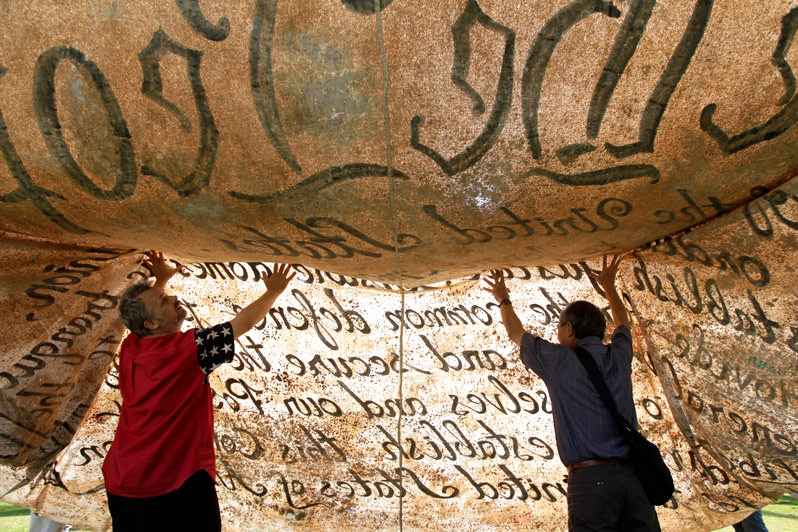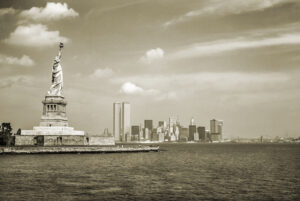A Reason to Watch the Sexist, Racist, Militarist, Corporate Rose Parade
Beneath the facade of festive glamour is an institution rife with the nation's ugliest faults. Occupy activists test a float made with a copy of the Constitution in 2011. The same year, Occupy protesters crashed the Tournament of Roses Parade in Pasadena, Calif. AP/Jae C. Hong
Occupy activists test a float made with a copy of the Constitution in 2011. The same year, Occupy protesters crashed the Tournament of Roses Parade in Pasadena, Calif. AP/Jae C. Hong
I hate parades. I have always hated the bright exuberance, the cheering and the flag waving. Every New Year’s Day, millions of people around the U.S. and the world tune in or gather in person to watch the Tournament of Roses Parade, also known as the Rose Parade. I live in Pasadena, home of the Rose Parade, and every year I watch thousands of families camped out on the streets of the city to secure a coveted spot from which to view the spectacle up close. Meanwhile, the moneyed classes pay for premium seating on bleachers set up for the occasion. But beneath the facade of festive glamour is an institution rife with sexism, racism, militarism and corporatism.
The Rose Parade has its origins in exclusivity and elitism. In 1890, when Pasadena was a magnet for wealthy East Coast Americans looking for temperate climates to vacation in during the winters, the Valley Hunt Club organized the first parade to show off the city. The hunting and fishing club, which continues to be featured in the parade for historical reasons, has had a problematic history of not admitting people of color.
Today the Rose Parade continues to remain ensconced within Pasadena’s well-to-do neighborhoods in the south of the city. Its annual route avoids by a wide berth poor and working-class communities of color, whose homes are concentrated in northwest Pasadena.
One of the most nausea-inducing aspects of the annual Rose Parade is its homage to sexism (and royalty) as embodied in the tradition of the Rose Queen. Each year, thousands of young women apply to be the Rose Queen, putting themselves through the demeaning rigors standard to beauty pageants like the widely ridiculed Miss America contests. Requirements for the Rose Queen and the members of her absurdly named “Royal Court” are strict: She must be between the ages of 17 and 21, unmarried, childless and enrolled in school. The usual promises of scholarship money are used to justify the sexist pageantry that culminates in a tawdry display of the chosen Rose Queen and Princesses dressed in ball gowns and tiaras, riding atop a float as the parade’s ultimate pieces of live decoration.
The royalty these young women are paraded as is symbolized by the $100,000 diamond and pearl tiara that the Rose Queen is required to wear — the approximate amount of the scholarship she will be awarded to further her education. But Rose Queens are expected to balance school work with about 150 events they are asked to attend during their yearlong tenure.
Incidentally, there is no Rose King. But there is a grand marshal each year and it is more often than not an older man. Grand marshals have included former presidents, actors, news anchors, military leaders and corporate CEOs. Unlike the Rose Queen, there are no requirements of age, marital status or parental status.
Not only is the Parade’s Rose Queen a sexist abomination, it also has, unsurprisingly, a racist past. It was more than 90 years after the first parade that a nonwhite Rose Queen was first selected: Asian-American Leslie Kawai. A few years later, in 1984, the first African-American Rose Queen was chosen. Since then, there have been only three others, including this year’s 17-year-old Madison Triplett. Only a handful of Latinas have ever been crowned Rose Queen, most in just the past decade.
For a good part of the Rose Parade’s existence, African-Americans were not even allowed to be part of it. In 1957, Joan Williams, a black city employee, was chosen to ride one of the floats, but she was disallowed at the last minute purely because of her race. Even though the Rose Parade has become a more racially diversified institution today, Williams, who will finally ride in the 2015 parade as a consolation prize 60 years later, has never received an official apology from the city of Pasadena.
If these are not reasons enough to disavow the parade, the annual New Year’s Day spectacle has also become a display of militarism. For years now, B-2 Stealth bombers pass over the city. We Americans may have the luxury of watching in awe and from positions of safety as the bomber jets fly over us, but the only context in which people outside the U.S. see them is when they are being bombed by our military, as the people of Afghanistan were during Operation Enduring Freedom. Sadly, many parade attendees thrill in the display of U.S. military might. As this newspaper reader defended the flyover, he claimed to “thank the lord for the protection and vigilance the U.S. military provides for our nation and its freedom.”
In 2014, a new display of F-16 fighter jets was added to the parade. The U.S. Air Force’s participation in the Rose Parade was lauded by one online magazine as a tribute to “the everyday, hard-working Airmen voluntarily serving America and defending freedom.” On the ground level of the parade, the U.S. Marines also regularly make an appearance, as part of the equestrian contingent.Two years ago, the Pentagon formally participated in the Rose Parade, even entering its float for the first time, smugly (and threateningly?) titled “Freedom Is Not Free.” The Defense Department spent $247,000 of taxpayer money to advertise itself in the name of Korean War veterans.
And finally, the Rose Parade has evolved into an institution by and for corporations. Some of the major corporations on the parade’s list of sponsors include luxury jeweler Tiffany & Co., weapons manufacturer Parsons, automaker Honda, food giant Dole, Princess Cruises (one of the world’s largest cruise companies) and even Nike, Disneyland, Hallmark, Trader Joe’s and Amazon’s Zappos.com.
For the past three years, the post-parade showcase of the floats has been sponsored by Miracle-Gro, a brand of the notorious Monsanto corporation. Disgustingly, this year’s theme is “urban revitalization,” which is meant to promote community gardens and green spaces. But of course Monsanto has been fighting small farmers and organic growers for decades, favoring industrial agriculture infused with pesticides and GMOs — values antithetical to community gardens.
Although many of the parade’s floats are by nonprofit entities (and sometimes cities that are battling bankruptcy), the majority of the parade is bought and paid for by corporate money. The corporate floats are simply branding for private companies whose greatest motive is profit. What better way to harvest eyeballs for corporate brands than to decorate giant versions of their logos with flowers, many of which are carefully applied by volunteer hands?
Perhaps the best use for the Rose Parade is subversion. In past years, activists have taken advantage of the millions of enthralled viewers to make political statements. Incidentally, last year’s parade actually featured an official gay-wedding themed float, but only after marriage equality became mainstream. It is highly unlikely that parade organizers would have allowed such a political statement even five years ago.
It is the unsanctioned political statements that make the Rose Parade slightly tolerable. A few groups have attempted to use the revered parade as a platform, with actions such as the China-themed float made by human rights activists, an Occupy Wall Street float and animal rights activism against Sea World.
Promisingly, 2014’s biggest political issue — police violence against communities of color — is the inspiration for an organized disruption of the 2015 Rose Parade. Pasadena-based activist Jasmine Richards with #BlackLivesMatter said, “I used to go to the Rose Parade as a little kid, but then it became so whitewashed that it was clear we weren’t even wanted there. So now we’re taking the streets back. This is the way the year is going to start. This is the way the year is going to end.” With that, it appears as though I finally have a good reason to attend the Rose Parade.
Your support is crucial…With an uncertain future and a new administration casting doubt on press freedoms, the danger is clear: The truth is at risk.
Now is the time to give. Your tax-deductible support allows us to dig deeper, delivering fearless investigative reporting and analysis that exposes what’s really happening — without compromise.
Stand with our courageous journalists. Donate today to protect a free press, uphold democracy and unearth untold stories.






You need to be a supporter to comment.
There are currently no responses to this article.
Be the first to respond.